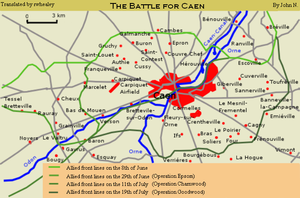Battle of Caen
| Battle for Caen | |||||||
|---|---|---|---|---|---|---|---|
| Part of Operation Overlord | |||||||
 Battle for Caen |
|||||||
|
|||||||
| Belligerents | |||||||
|
|
|
||||||
| Commanders and leaders | |||||||
|
|
|
||||||
| Strength | |||||||
| 3 armoured divisions 11 infantry divisions 5 Armoured Brigades 3 Tank Brigades |
7 infantry divisions 8 Panzer divisions 3 heavy tank battalions |
||||||
| Casualties and losses | |||||||
| c. 50,539 casualties | Unknown 550 tanks |
||||||
The Battle for Caen from June–August 1944 was a battle of the Second World War between Allied forces of the mainly Anglo-Canadian Second Army and German forces of Panzergruppe West during the Battle of Normandy. The Allies aimed to take Caen, one of the largest cities in Normandy on D-Day. Caen was an important Allied objective because it lay astride the Orne River and Caen Canal; these two water obstacles could strengthen a German defensive position if not crossed. Caen was a road hub and the side which held it could shift forces rapidly. The area around Caen was open, compared to the bocage country in the west of Normandy and was valuable land for airfields.
On D-Day, 6 June 1944, Caen was an objective for the 3rd British Infantry Division and remained the focal point for a series of battles throughout June, July and into August. The battle did not go as planned for the Allies, instead dragging on for two months, because German forces devoted most of their reserves to holding Caen, particularly their armoured divisions. As a result, German forces facing the American invasion thrust further west were spread thin, relying on the rough terrain of the back country to slow down the American advance up to Operation Cobra. With so many German divisions held up defending Caen, the American forces were eventually able to break through to the south and east, threatening to encircle the German forces in Normandy from behind. The old city of Caen—with many buildings dating back to the Middle Ages—was destroyed by Allied bombing and the fighting. The reconstruction of Caen lasted until 1962; today, little of the pre-war city remains.
On 6 June 1944, Allied forces invaded France by launching Operation Neptune, the beach landing operation of Operation Overlord. A force of several thousand ships assaulted the beaches in Normandy, supported by about 3,000 aircraft. The D-Day landings were successful, but the Allied forces were unable to take Caen as planned. The Allies also employed airborne troops. The US 82nd Airborne Division and US 101st Airborne Division, as well as the British 6th Airborne Division (with the attached 1st Canadian Parachute Battalion), were inserted behind the enemy lines. The British and Canadian paratroopers behind Sword Beach were tasked in Operation Tonga with reaching and occupying the strategically important bridges such as Horsa and Pegasus, as well as to take the artillery battery at Merville to hinder the forward progress of the German forces. They managed to establish a bridgehead north of Caen, on the east bank of the Orne, that the Allied troops could use to their advantage in the battle for Caen. The first operation intended to capture Caen was the initial landings on Sword Beach by the British 3rd Infantry Division on 6 June. Despite being able to penetrate the Atlantic Wall and push south the division was unable to reach the city, their final objectives according to the plan, and in fact fell short by 3.7 mi (6.0 km). The 21st Panzer Division launched several counter-attacks during the afternoon which blocked the road to Caen.
...
Wikipedia
